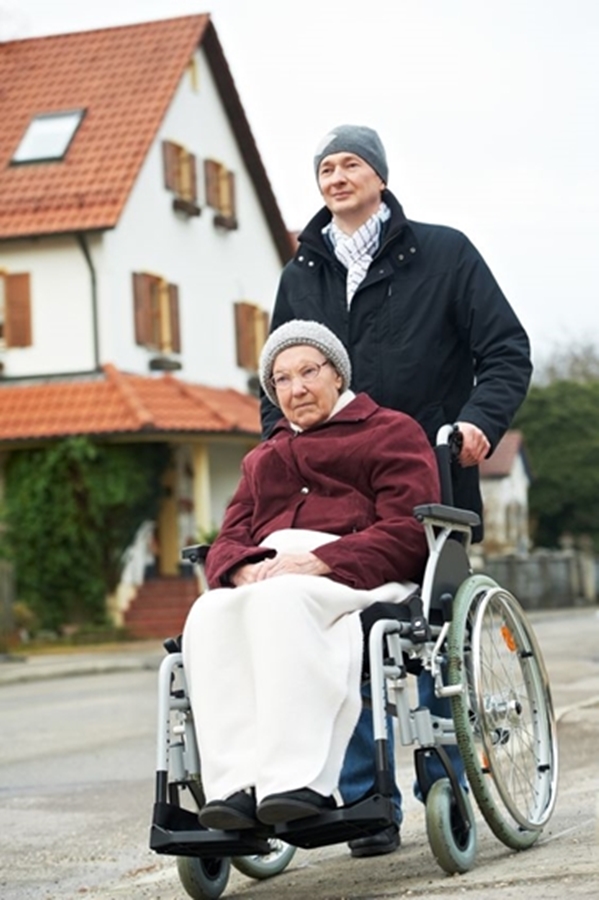Of all the caregiving responsibilities I do daily, the one I think is most important is inspecting and caring for Lynn’s skin. For most people, getting a cut, scratch, or other skin irritation is no big deal. They get a little Neosporin ointment, slap a Band-Aid, and go about their usual routine. For someone who spends 20 out of 24 hours sitting in a chair, when I examine his buttock and find a skin tear, it’s an “oh, no!” moment in my life.
Did you know that the skin is the largest organ in the body? It has many purposes: it protects us from nasties crawling into our body, warns of danger, regulates temperature, manages waste, and other things. Diet, hydration, hygiene, and circulation are essential for skin to be healthy. If any of these are out of balance, the skin is not as able to defend itself. With someone who has MS and who spends a great deal of time in one position, Lynn’s greatest risk of skin breakdown is circulatory. As gravity tends to pool blood into the lowest regions of his body, his greatest risk areas are his buttocks and feet. His buttock because the majority of his body weight is compressing the blood flow to his buttock as he sits, and his feet are further away from the heart, and the muscles in his legs are severely compromised. He uses an electronic peddler to keep his legs moving and circulation flowing better, but his feet are secured to peddles with bandages so they will stay in place, resulting in potential areas of friction.
His buttock is even more at risk. He sits on an air cushion all day, which helps, but that doesn’t remove the fact that this 195-pound man is putting most of that weight onto a tailbone with almost no fat on it anymore. There is very little fat cushion remaining between the bone and skin, so as moisture builds from body heat, causing sweating, and as his legs slightly move with the peddling motion or occasional shifting of his weight, friction occurs. If the skin is in good shape, it can withstand the movement, and all is well. If, for any reason, his skin is inflamed due to too much pressure in an area, irritation from toileting, or the skin has become mottled, then it’s more prone to sloughing or tearing.
If you see irritation or redness that doesn’t improve from just changing positions, that’s a signal to spring into action. Determine what’s causing the problem: too much moisture, not enough, resting on something too hard for too long, diet or hydration needs attention, etc. If you don’t fix what caused the problem, the condition will get worse, or if you get it better, it will return.
I use a lot of lotion on dry skin to prevent issues with Lynn’s feet and legs and prevent cracks from developing. I use pads like band-aids or pads in foot care aisles for corns or calluses. I keep his nails cut short enough that the shoes won’t push the toes together and cause a scratch. Since his feet are usually strapped into the peddles of the peddler, I put pads on both heels, on the outer side of both feet just below the little toe, and a waterproof extra-large band-aid over the top of his foot. So far, he has not had any significant foot wounds.
His buttock is another matter. I’ve been fortunate that I have always been able to get wounds there to heal, but it takes a lot of diligence to do that, and if I find I can’t see healing (new pink skin rather than enlarging of the area) on my own in two-three days, then I call the doctor. My first action is determining if I need more or less moisture in the area. It’s nearly always less for that area. Bandaging is more difficult as most bandages are not designed to fit around the buttock area but to work on straight areas. There is also the issue of being able to keep the bandage from getting soiled. If it does, it must be changed so the wound underneath doesn’t get contaminated. If you are, therefore, going to change the bandage often, it’s important to use a non-stick covering. If you use dry gauze, you’ll need ointment to keep it from sticking, so you cannot eliminate moisture. I like to use Telfa or other non-stick gauze pads and secure them with paper tape. These products keep the new skin from tearing open when the bandage is removed. If the wound needs something to dry and help it heal, I use Silveabsorb gel, which usually helps.
If my efforts are not working, I call the doctor for an order. If you can take a picture of the wound to send, that will often help the doctor assess the situation without requiring an office visit, but you need to do a thorough job of telling the doctor what you have.
Here are some pointers on describing the wound:
- If you take a picture, place a ruler or tape measure in the shot so the doctor can gauge the size.
- Measure the widest and longest areas of the wound, recording the size in centimeters.
- The doctor needs to know how deep the wound is. A stage 1 wound is just red skin and something like Skin-prep or other liquid skin protector often will take care of this. Stage 2 wounds have lost the top layer of skin; sometimes, they look like blisters that broke open or bad sunburns that are peeling. Stage 3 has a crater appearance beyond the skin into the fat layers. Stage 4 is the worst; the ulcer has worked into muscle, tendons, joints, and perhaps bone. Extensive long-term damage has occurred.
- Describe what color, if any, the liquid in the wound appears to be. Clear or mucous color is usually normal, but an infection may be present if it’s getting darker yellow, green, or brown. Also, note if there is any smell. The smell is bad; it usually means infection
- Is there any pain? Pain is usually present in Stages 1 and 2 but not in Stages 3 and 4 due to the extensive damage.
There are several products available for use in skin care. Talk to your doctor about what is best for your situation based on the general healthiness of the skin and the patient. They all have pros and cons to support or stir away from the product. What do you use, how often, and when is a discussion to have with your doctor and/or home health agency? The most important point is not to ignore it. Keep that skin intact and defensible.
This article originally appeared on Multiplesclerosis.Net by Health-Union, LLC, and has been reposted with permission.



